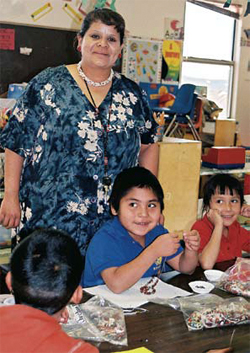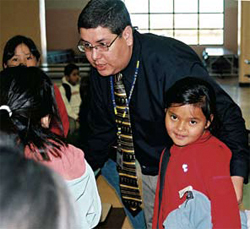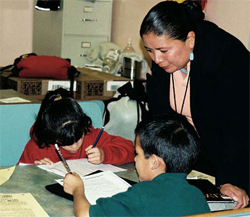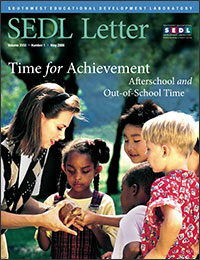Knowledge, Excellence, Wisdom, and Action Through the Arts After School

Santo Domingo artist Cheryl Lucero teaches students to make traditional necklaces.
The artist from Santo Domingo Pueblo, New Mexico, is working intently. He is carefully stringing together beads of different colors and shapes to make a treasure necklace. He is quiet and focused. He is also 7 years old.
Incredibly, there are six more first graders in the group, all just as intent on making a beautiful treasure necklace, much like their grandparents, parents, aunts, and uncles have made. In another room, third-grade students are busily and precisely sanding and painting pottery pieces adorned with native designs. Fifth graders are participating in the Youth Leadership group. Other students are playing soccer, and still others are receiving reading instruction or computer instruction. Later in the afternoon, students will attend Homework Club. It is a typical day in the Santo Domingo School's afterschool program, the KEWA 21st Century Community Learning Center Program.
Besides these afterschool activities, students also have the opportunity to receive tutoring throughout the school year, play basketball, and participate in an exercise program, a nutrition program, storytelling, and a range of arts classes. There is also a math, engineering, and science program for grades 6, 7, and 8.
Of the afterschool program's variety of activities, 21st Century Project Director JoAnn Melchor explains, "We look at different opportunities for students—different opportunities for them to learn and grow."
Collaborative Effort, Cultural Vision
K–5 principal Bryan Garcia reports that the afterschool program is a collaborative effort among the school, the pueblo, and the 21st Century Community Learning Center Program. "It addresses the needs of the whole child," he says. "The program helps meet academic needs and provides enrichment activities that address the cultural needs of our students."
The opportunities at Santo Domingo are often related to the unique culture of the school and community. Melchor explains, "The afterschool program and our school in general need to address the cultural aspects of our pueblo life because our culture is so critical in the lives of our students, parents, and families. There has to be a balance [between] what we teach our children in day school and after school. Some of our children come from families that have strong traditions, and these students appreciate knowing that the arts of jewelry- and pottery-making have sustained our people since time immemorial."

Students sand and paint pottery in a class taught by potter Manuelita Lovato.
Indeed, several of the afterschool staff members mentioned the importance of culture in what they were teaching after school. Cheryl Lucero, who teaches jewelry-making, says she would like her students to carry on the pueblo's tradition of making jewelry. "If they do that, I'll be happy," she says, beaming at her first-grade group.
Much of the culture of Santo Domingo lies in the pueblo's language, Keres. Keres is an oral language spoken at seven pueblos in New Mexico. In fact, Santo Domingo was the name given to the pueblo by the Spanish in the 1600s. The pueblo's preferred, traditional name is Kewa. The school has incorporated Kewa into its vision: "A learning community continuously committed to Knowledge, Excellence, Wisdom, Action—KEWA."
Garcia explains, "The afterschool program—through strong cultural connections and a focus on increasing academic achievement—creates a learning environment where students strive for increased knowledge and excellence in what they do, wisdom through character development, and the action needed to realize their dreams." Garcia adds that wisdom through character development includes respect, responsibility, caring, trustworthiness, citizenship, and fairness.

Principal Bryan Garcia says the afterschool program helps reinforce strong family connections.
About 70–150 students attend the afterschool program, which is in its third year. Attendance fluctuates with the school schedule. Many of the students don't come after the New Mexico Standards-Based Assessment (NMSBA) is given; attendance also drops when the weather warms up in the spring.
Melchor is passionate about the program, the children, and her work. She has spent her career working for and with children in New Mexico through several programs, including Futures for Children, the American Indian Graduate Center, and the New Mexico Center for Dispute Resolution. While giving a workshop to Navajo students in Alamo, New Mexico, she realized that she needed to focus on native children and was drawn to the idea of working directly with Santo Domingo Pueblo children through the 21st Century Community Learning Center grant. She attributes much of the success of the program, however, to the support it receives from Garcia Middle School principal Richard Torralba, the leadership at Bernalillo Public Schools, and the Santo Domingo tribal leadership.
Today, the cheerful afterschool project director is juggling many tasks. Melchor has been to nearby Albuquerque to buy snacks that will be distributed to the students in grades 3–8 who are taking the NMSBA tests all week. Two teachers stop by the office to coordinate plans for one project or another. Christian, a third grader, checks in to see what the snacks will be during tomorrow's testing. In the hallway other students greet Melchor, all happy to see her. The grandparents of two children who participate in the afterschool program stop to chat as well. The atmosphere at Santo Domingo School is warm and welcoming. Everyone is treated with respect.
Garcia says that as a result of the strong cultural connections in the afterschool program, "Our families feel connected to our staff, which creates a comfort level that is conducive to increased family involvement. Families are welcome to visit, volunteer, and participate on a daily basis. In addition, there are many learning opportunities for families through parent nights focused on topics such as literacy, art, math, career development, and parenting."

KEWA CCLC program director JoAnn Melchor enjoys helping students with their homework.
Linking Arts and Academics
Santo Domingo School has been identified by the National Partnership for Quality Afterschool Learning as one of the promising practices sites with an arts focus. Suzanne Stiegelbauer, an associate professor at Texas State University and a consultant to the National Partnership, says the arts and academics go hand in hand and that this is apparent at Santo Domingo School. She reports that the afterschool arts program at the school is "powerful in that it keeps kids engaged in traditions and their pueblo's economic base while drawing on math and literacy skills." She explains that in the pottery classes, students use mathematical concepts to measure designs for the pots, determine what size their piece should be and what percentage of mixtures are needed to make the glaze, estimate the cost of materials that went into making their pots, and figure out what price they should charge when selling their pottery. In some art classes, the students keep journals, helping to reinforce literacy skills. Manuelita Lovato, a pottery teacher, has the students make notes about the meaning of their designs in their journals.
"When the afterschool program supports the school goals and focus areas," says Garcia, "the students benefit greatly from the additional learning support."
At Santo Domingo, this support is facilitated by the high proportion of afterschool staff who are regular teachers or paraprofessionals during the school day. The Santo Domingo faculty look at the achievement levels of each student and their test scores and make recommendations for tutoring. Afterschool staff also work closely with the regular staff to find out what kind of help students need. For example, Corine Lovato, the afterschool computer teacher, checks with the students' regular teachers to find out what skills they need to work on in the computer lab. As a result, on any given day, she has some students working on keyboarding skills, others working on computerized math or reading programs, and others who are free to play computer games or work on homework.
Much time in the afterschool program is spent preparing students for the NMSBA tests. Teachers look at the test scores and achievement levels of each student and make recommendations for tutoring. The afterschool program coordinates with the Day Foundation to provide tutoring to Santo Domingo students, and the afterschool staff also works with the students to prepare them for testing. Karen Adams, an art teacher on the Santo Domingo faculty who works in the afterschool program, says that a great deal of the coaching regarding the NMSBA testing focuses on helping students learn to take the tests and the importance of showing their work and their thought processes on paper.
One thing that strikes visitors to the KEWA 21st Century Community Learning Center Program is student behavior. Although students are having fun, they are courteous to each other and to teachers, even while in the gym playing soccer. The afterschool program coordinates its discipline policy with that of the school. "We follow the same rules and regulations as the day school. The consequences and rewards are the same for day and after school," Melchor says.
Everyone in the school participates in the school's incentive program. This includes the School Dollars program, in which students earn "dollars" for good behavior, attendance, and excellence in academic work. Twice a month students have the opportunity to redeem the dollars at the school store for school supplies, sports equipment, clothes, jewelry, and other items.
And what about student outcomes related to the afterschool program? Students, families, and teachers are surveyed regularly as part of the program evaluation. Many students who attend the program regularly show improvement in behaviors related to academic work. They turn in homework more regularly than before, they complete their homework to their teachers' satisfaction, their attendance is improved, and teachers believe their motivation to learn is higher—all factors in academic success.
At 5 p.m., two yellow school buses pull up in front of the school. A flurry of good-byes are hollered up and down the hallway, hugs are dispensed, and suddenly it is quiet. Another day of arts and academics after school has come to an end at Santo Domingo.
Next Article: New Study Shows High-Performing Afterschool Programs Share Five Characteristics

